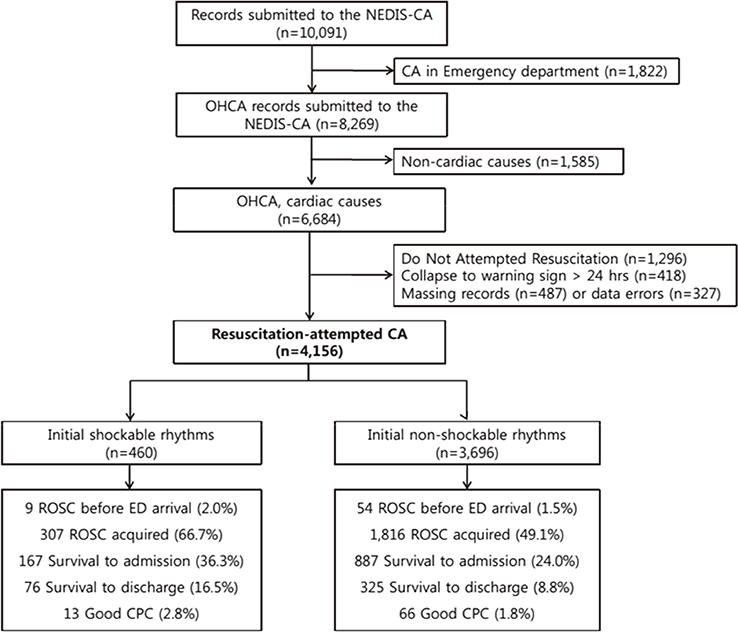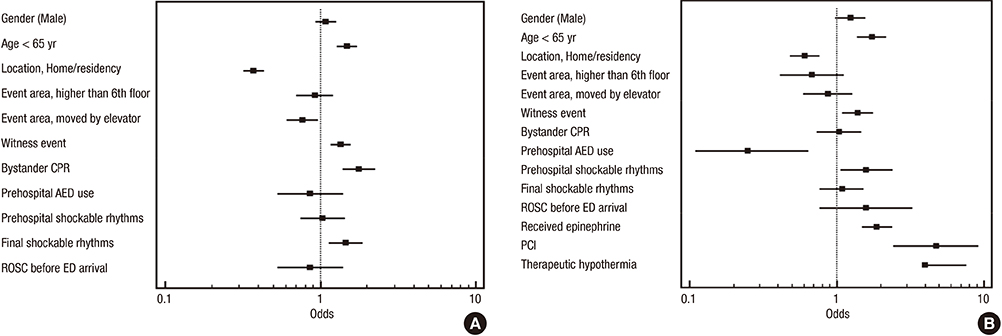Epidemiology and Outcomes in Out-of-hospital Cardiac Arrest: A Report from the NEDIS-Based Cardiac Arrest Registry in Korea
- Affiliations
-
- 1The ACLS Committee of the Korean Association of Cardiopulmonary Resuscitation, Seoul, Korea. emmam@knu.ac.kr
- 2Department of Emergency Medicine, Gachon University Gill Hospital, Incheon, Korea.
- 3Department of Emergency Medicine, School of Medicine, Ajou University, Suwon, Korea.
- 4Department of Emergency Medicine, Wonju College of Medicine, Yonsei University, Wonju, Korea.
- 5Division of Cardiology, Department of Medicine, College of Medicine, The Catholic University of Korea, Seoul, Korea.
- 6National Emergency Medical Center, Seoul, Korea.
- 7Department of Emergency Medicine, School of Medicine, Kyungpook National University, Daegu, Korea.
- KMID: 2155453
- DOI: http://doi.org/10.3346/jkms.2015.30.1.95
Abstract
- Sudden cardiac death (SCD) is a significant issue affecting national health policies. The National Emergency Department Information System for Cardiac Arrest (NEDIS-CA) consortium managed a prospective registry of out-of-hospital cardiac arrest (OHCA) at the emergency department (ED) level. We analyzed the NEDIS-CA data from 29 participating hospitals from January 2008 to July 2009. The primary outcomes were incidence of OHCA and final survival outcomes at discharge. Factors influencing survival outcomes were assessed as secondary outcomes. The implementation of advanced emergency management (drugs, endotracheal intubation) and post-cardiac arrest care (therapeutic hypothermia, coronary intervention) was also investigated. A total of 4,156 resuscitation-attempted OHCAs were included, of which 401 (9.6%) patients survived to discharge and 79 (1.9%) were discharged with good neurologic outcomes. During the study period, there were 1,662,470 ED visits in participant hospitals; therefore, the estimated number of resuscitation-attempted CAs was 1 per 400 ED visits (0.25%). Factors improving survival outcomes included younger age, witnessed collapse, onset in a public place, a shockable rhythm in the pre-hospital setting, and applied advanced resuscitation care. We found that active advanced multidisciplinary resuscitation efforts influenced improvement in the survival rate. Resuscitation by public witnesses improved the short-term outcomes (return of spontaneous circulation, survival admission) but did not increase the survival to discharge rate. Strategies are required to reinforce the chain of survival and high-quality cardiopulmonary resuscitation in Korea.
MeSH Terms
-
Cardiopulmonary Resuscitation/*mortality
Critical Care/*statistics & numerical data
Death, Sudden, Cardiac/*epidemiology
Electric Countershock/mortality
Emergency Medical Services
Humans
Out-of-Hospital Cardiac Arrest/*epidemiology/*mortality/therapy
Registries
Republic of Korea/epidemiology
Survival Rate
Treatment Outcome
Figure
Cited by 4 articles
-
The Effect of Transport Time Interval on Neurological Recovery after Out-of-Hospital Cardiac Arrest in Patients without a Prehospital Return of Spontaneous Circulation
Jeong Ho Park, Yu Jin Kim, Young Sun Ro, Sola Kim, Won Chul Cha, Sang Do Shin
J Korean Med Sci. 2019;34(9):. doi: 10.3346/jkms.2019.34.e73.New Termination-of-Resuscitation Models and Prognostication in Out-of-Hospital Cardiac Arrest Using Electrocardiogram Rhythms Documented in the Field and the Emergency Department
Dong Eun Lee, Mi Jin Lee, Jae Yun Ahn, Hyun Wook Ryoo, Jungbae Park, Won Young Kim, Sang Do Shin, Sung Oh Hwang,
J Korean Med Sci. 2019;34(17):. doi: 10.3346/jkms.2019.34.e134.Recent Update in Out-of-Hospital Cardiac Arrests in Korea
Namsik Yoon
Korean Circ J. 2021;51(10):875-876. doi: 10.4070/kcj.2021.0281.The 10-Year Trend of Out-of-hospital Cardiac Arrests: a Korean Nationwide Population-Based Study
Seung-Young Roh, Jong-Il Choi, Sang Hyun Park, Yun Gi Kim, Jaemin Shim, Jin-Seok Kim, Kyung Do Han, Young-Hoon Kim
Korean Circ J. 2021;51(10):866-874. doi: 10.4070/kcj.2021.0127.
Reference
-
1. Boyd TS, Perina DG. Out-of-hospital cardiac arrest. Emerg Med Clin North Am. 2012; 30:13–23.2. Berdowski J, Berg RA, Tijssen JG, Koster RW. Global incidences of out-of-hospital cardiac arrest and survival rates: Systematic review of 67 prospective studies. Resuscitation. 2010; 81:1479–1487.3. Sasson C, Rogers MA, Dahl J, Kellermann AL. Predictors of survival from out-of-hospital cardiac arrest: a systematic review and meta-analysis. Circ Cardiovasc Qual Outcomes. 2010; 3:63–81.4. Lloyd-Jones D, Adams RJ, Brown TM, Carnethon M, Dai S, De Simone G, Ferguson TB, Ford E, Furie K, Gillespie C, et al. American Heart Association Statistics Committee and Stroke Statistics Subcommittee. Heart disease and stroke statistics: 2010 update: a report from the American Heart Association. Circulation. 2010; 121:e46–e215.5. Go AS, Mozaffarian D, Roger VL, Benjamin EJ, Berry JD, Borden WB, Bravata DM, Dai S, Ford ES, Fox CS, et al. American Heart Association Statistics Committee and Stroke Statistics Subcommittee. Heart disease and stroke statistics: 2013 update: a report from the American Heart Association. Circulation. 2013; 127:e6–e245.6. Ahn KO, Shin SD, Suh GJ, Cha WC, Song KJ, Kim SJ, Lee EJ, Ong ME. Epidemiology and outcomes from non-traumatic out-of-hospital cardiac arrest in Korea: a nationwide observational study. Resuscitation. 2010; 81:974–981.7. Ro YS, Shin SD, Song KJ, Lee EJ, Kim JY, Ahn KO, Chung SP, Kim YT, Hong SO, Choi JA, et al. A trend in epidemiology and outcomes of out-of-hospital cardiac arrest by urbanization level: a nationwide observational study from 2006 to 2010 in South Korea. Resuscitation. 2013; 84:547–557.8. Nichol G, Thomas E, Callaway CW, Hedges J, Powell JL, Aufderheide TP, Rea T, Lowe R, Brown T, Dreyer J, et al. Resuscitation Outcomes Consortium Investigators. Regional variation in out-of-hospital cardiac arrest incidence and outcome. JAMA. 2008; 300:1423–1431.9. Brooks SC, Schmicker RH, Rea TD, Aufderheide TP, Davis DP, Morrison LJ, Sahni R, Sears GK, Griffiths DE, Sopko G, et al. ROC Investigators. Out-of-hospital cardiac arrest frequency and survival: evidence for temporal variability. Resuscitation. 2010; 81:175–181.10. Atwood C, Eisenberg MS, Herlitz J, Rea TD. Incidence of EMS-treated out-of-hospital cardiac arrest in Europe. Resuscitation. 2005; 67:75–80.11. Iwami T, Nichol G, Hiraide A, Hayashi Y, Nishiuchi T, Kajino K, Morita H, Yukioka H, Ikeuchi H, Sugimoto H, et al. Continuous improvements in "chain of survival" increased survival after out-of-hospital cardiac arrests: a large-scale population-based study. Circulation. 2009; 119:728–734.12. National Emergency Department Information System data. accessed on 30 October 2012. Available at http://edis.nemc.go.kr.13. National Emergency Medical Center. 2009 Yearbook of emergency medical statistics. accessed on 30 October 2012. Available at http://www.nemc.or.kr/.14. Ko Y, Kim HJ, Cha ES, Kim J, Lee WJ. Emergency department visits due to pesticide poisoning in South Korea, 2006-2009. Clin Toxicol (Phila). 2012; 50:114–119.15. McNally B, Robb R, Mehta M, Vellano K, Valderrama AL, Yoon PW, Sasson C, Crouch A, Perez AB, Merritt R, et al. Out-of-hospital cardiac arrest surveillance: Cardiac Arrest Registry to Enhance Survival (CARES), United States, October 1, 2005-December 31, 2010. MMWR Surveill Summ. 2011; 60:1–19.16. Valderrama AL, Fang J, Merritt RK, Hong Y. Cardiac arrest patients in the emergency department-National Hospital Ambulatory Medical Care Survey, 2001-2007. Resuscitation. 2011; 82:1298–1301.17. Zive D, Koprowicz K, Schmidt T, Stiell I, Sears G, Van Ottingham L, Idris A, Stephens S, Daya M. Centers for Disease Control and Prevention. Variation in out-of-hospital cardiac arrest resuscitation and transport practices in the Resuscitation Outcomes Consortium: ROC Epistry-Cardiac Arrest. Resuscitation. 2011; 82:277–284.18. Glover BM, Brown SP, Morrison L, Davis D, Kudenchuk PJ, Van Ottingham L, Vaillancourt C, Cheskes S, Atkins DL, Dorian P. Resuscitation Outcomes Consortium Investigators. Wide variability in drug use in out-of-hospital cardiac arrest: a report from the resuscitation outcomes consortium. Resuscitation. 2012; 83:1324–1330.19. Axelsson C, Claesson A, Engdahl J, Herlitz J, Hollenberg J, Lindqvist J, Rosenqvist M, Svensson L. Outcome after out-of-hospital cardiac arrest witnessed by EMS: changes over time and factors of importance for outcome in Sweden. Resuscitation. 2012; 83:1253–1258.20. Adielsson A, Hollenberg J, Karlsson T, Lindqvist J, Lundin S, Silfverstolpe J, Svensson L, Herlitz J. Increase in survival and bystander CPR in out-of-hospital shockable arrhythmia: bystander CPR and female gender are predictors of improved outcome. Experiences from Sweden in an 18-year perspective. Heart. 2011; 97:1391–1396.21. Lee MJ, Hwang SO, Cha KC, Cho GC, Yang HJ, Rho TH. Influence of nationwide policy on citizens' awareness and willingness to perform bystander cardiopulmonary resuscitation. Resuscitation. 2013; 84:889–894.22. Na SH, Shin SD, Ro YS, Lee EJ, Song KJ, Park CB, Kim JY. Specific activity types at the time of event and outcomes of out-of-hospital cardiac arrest: a nationwide observational study. J Korean Med Sci. 2013; 28:320–327.23. Shin SD, Suh GJ, Ahn KO, Song KJ. Cardiopulmonary resuscitation outcome of out-of-hospital cardiac arrest in low-volume versus high-volume emergency departments: An observational study and propensity score matching analysis. Resuscitation. 2011; 82:32–39.24. Mader TJ, Nathanson BH, Millay S, Coute RA, Clapp M, McNally B. CARES Surveillance Group. Out-of-hospital cardiac arrest outcomes stratified by rhythm analysis. Resuscitation. 2012; 83:1358–1362.25. Kim JY, Shin SD, Ro YS, Song KJ, Lee EJ, Park CB, Hwang SS. CardioVascular Disease Surveillance (CAVAS) investigators. Post-resuscitation care and outcomes of out-of-hospital cardiac arrest: a nationwide propensity score-matching analysis. Resuscitation. 2013; 84:1068–1077.26. Lin S, Callaway CW, Shah PS, Wagner JD, Beyene J, Ziegler CP, Morrison LJ. Adrenaline for out-of-hospital cardiac arrest resuscitation: a systematic review and meta-analysis of randomized controlled trials. Resuscitation. 2014; 85:732–740.
- Full Text Links
- Actions
-
Cited
- CITED
-
- Close
- Share
- Similar articles
-
- A Case of Cardiac Arrest due to Oculoeardiac Reflex: A Case Report
- Recurrent Cardiac Arrest during a Nontransplant Operation Due to Variant Angina in a Liver Transplantation Patient
- Medullary Infarction Presenting as Sudden Cardiac Arrest: Report of Two Cases and Review of the Literature
- Concept Analysis of Cardiac Arrest: Identifying the Critical Attributes and Empirical Indicators
- Cardiac Arrest During Pediatric Anesthesia



